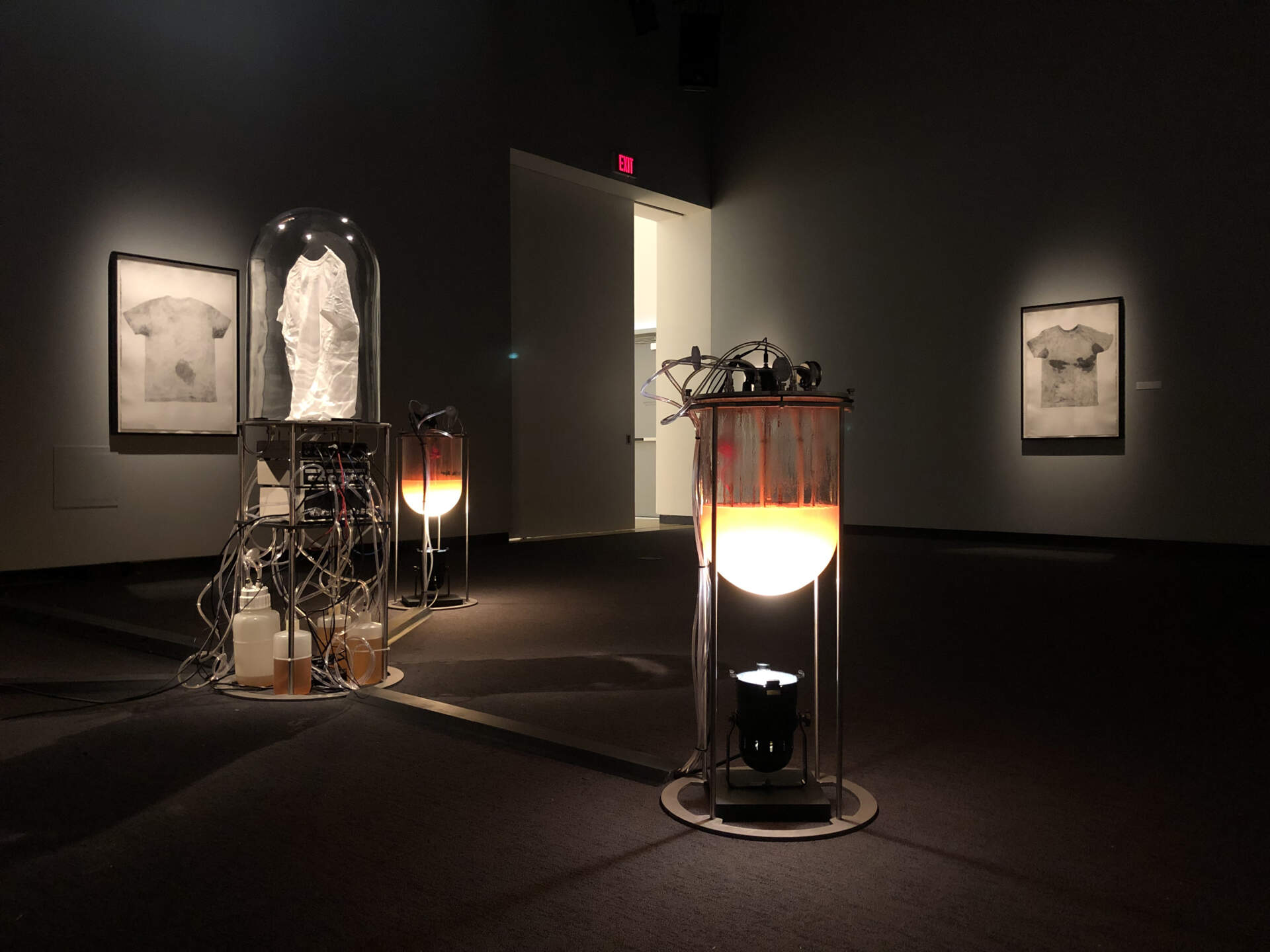
Paul Vanouse, Labor
Must-smell exhibition that scientifically fills gallery space with the natural scent of human exertion
Past
Jan 11, 2019 - Mar 31, 2019
What does labor smell like? The Burchfield Penneyl tackles that sweaty, steamy question by scientifically creating it in an exhibition by Paul Vanouse, award-winning University at Buffalo professor of art and director of Coalesce: Center for Biological Art. The scent of human exertion in stressful conditions is created on-site.
People are not involved in making the smell. It will be formed by bacteria procreating in three industrial fermenters in the middle of the Center’s project space. These 80-gallon vessels, standing human height, will be cradled by temperature regulating units and motorized mixers connected to gas, nutrient and waste canisters by hoses. Researcher Solon Morse, Coalesce lab manager, is scientific collaborator on the project.
“Each fermenter incubates a unique species of human skin bacteria responsible for the primary scent of sweat: Staphylococcus epidermis, Coryne and Propionibacterium,” explains Vanouse, recipient of the Award of Distinction in Hybrid Art at the prestigious 2017 Prix Ars Electronica, a cyberarts global festival and competition. “As these bacteria digest simple sugars and fats, they create the distinct smells associated with human exertion, stress and anxiety. Their scents will combine in the central chamber in which a sweatshopicon, the white t-shirt, is infused as scents disseminate. This odor is expected to grow stronger throughout the exhibition.”
Labor reflects industrial society’s shift from human and machine labor, to increasingly pervasive forms of microbial manufacturing. “Today, microbes produce a wide range of products, including enzymes, foods,beverages, feedstocks, fuels and pharmaceuticals. They literally live to work,” said Vanouse “These newindustrial processes point to a deepening exploitation of life and living processes: the design, engineering, management and commodification of life itself. In Labor, the microorganisms ironically produce the scent of sweat, not as a vulgar bi-product of production, like in factories of the 19th and 20th centuries, but as a nostalgic end-product.”
Labor is also a representation of our changing understanding of what we are. Microbes in and on the human body vastly outnumber human cells and they help regulate many bodily processes, from digestive and immune systems to emotional and physiological responses like sweating. “Our microbiota is integral to who and what we are, and complicates any simplistic sense of self,” added Vanouse. “Likewise, the smell of the perspiring body is not just a human scent, unless we are willing to redefine what we mean by human?”
About Paul Vanouse
Vanouse has been working in emerging media forms since 1990. Interdisciplinarity and impassioned amateurism guide his art practice. His electronic cinema, biological experiments, and interactive installations have been exhibited in over 20 countries and widely across the US. Venues have included: Walker Art Center, Albright-Knox Art Gallery, Carnegie Museum, Andy Warhol Museum, New Museum, Museo Nacional de Bellas Artes in Buenos Aires, Louvre in Paris, Haus Der Kulturen Der Welt, Berlin, Zentrum fur Kunst und Medientechnologie in Karlsrhue, Centre de Cultura Contemporania in Barcelona, and TePapa Museum in Wellington, New Zealand.
Recent large-scale solo exhibitions include: Schering Foundation in Berlin (2011), Kapelica Gallery in Ljubljana (2011), Muffathalle in Munich (2012), and Beall Center at UC Irvine, California (2013). This work has been discussed in journals including: Art Journal, Art Papers, Art News, Flash Art International, Leonardo, New Scientist, New Art Examiner, New York Times and numerous academic books on art and technology.
Vanouse’s artworks have been funded by Renew Media Arts Fellowship (formerly known as Rockefeller New Media Fellowship, 2008), Creative Capital (2006), New York State Council on the Arts project grant (2000, 2005), New York Foundation for the Arts Fellowship (2002), Pennsylvania Council on the Arts project grants (94, 95, 98), PCA Fellowship (98), National Science Foundation (1997). He has received awards at festivals including Prix ARS Electronica (2017, 2013, 2010, 2007) in Linz, Austria, and Vida, Art and Artificial Life competition (2002, 2011), in Madrid, Spain. Museum commissions include the Walker Art Center for “The Consensual Fantasy Engine online” (1998), and the Henry Art Gallery in Seattle for “The Relative Velocity Inscription Device” (2002).
For the past decade, Vanouse has been specifically concerned with forcing the arcane codes of scientific communication into a broader cultural language. His recent projects, “Latent Figure Protocol”, “Ocular Revision”, “Suspect Inversion Center” and “America Project” use molecular biology techniques to challenge “genome-hype” and to confront issues surrounding DNA fingerprinting. Vanouse holds a BFA from the University at Buffalo (1990) and an MFA from Carnegie Mellon University (1996).
About Solon Morse
Solon Morse interests include evolutionary biology, ecology, and conservation. He has a PhD in Evolutionary Biology from the University at Buffalo and a Master’s in Ecology from the University of Illinois.
The Labor Project would like to thank scientific collaborator Solon Morse, University at Buffalo. Special thanks to: Don Metz, Scott Propeack, Tullis Johnson, Jennifer Surtees, Jerry Koudelka, Tom Gruenauer, Shanna Snider and Jeff Sherven without whom this exhibition would not have been possible. Additional thanks to Eileen Sylves, Kristie Reilly, Kevin Cullinan, Gary Nottingham, Domenic Licata, Sara Thomas, Mizin Shin, Alyssa Crane, Leonardo Aranda Brito, Darya Warner, Robert Jones, John Santomieri, Martin Chittum, Goldie Segol, and Fern Johansson from University at Buffalo, Marta De Menezes, Cultivamos Cultura, Portugal, Ulla Taipale, Pia Lindman, Marika Hellman, Aalto University, Finland and Jens Hauser, University of Copenhagen, Denmark.
The exhibition is supported by the New York State Council on the Arts Electronic Media and Film Program, Coalesce Center for Biological Art, University at Buffalo, Genome Environment and Microbiome Community of Excellence, University at Buffalo, Humanities Institute, University at Buffalo, CAS Machine Shop, University at Buffalo, Print Media Lab, Department of Art, University at Buffalo, Angewandte Innovation Lab, University of Applied Arts, Vienna, Austria, Biofilia: Base for Biological Arts, Aalto University, Helsinki, Finland, HIAP Artist in Residence program, Helsinki, Finland, Cultivamos Cultura Artist in Residence program, São Luis, Portugal.
The artist would like to extend an extra special thanks to: Joan Linder, Rafael Vanouse and Lucien Vanouse.